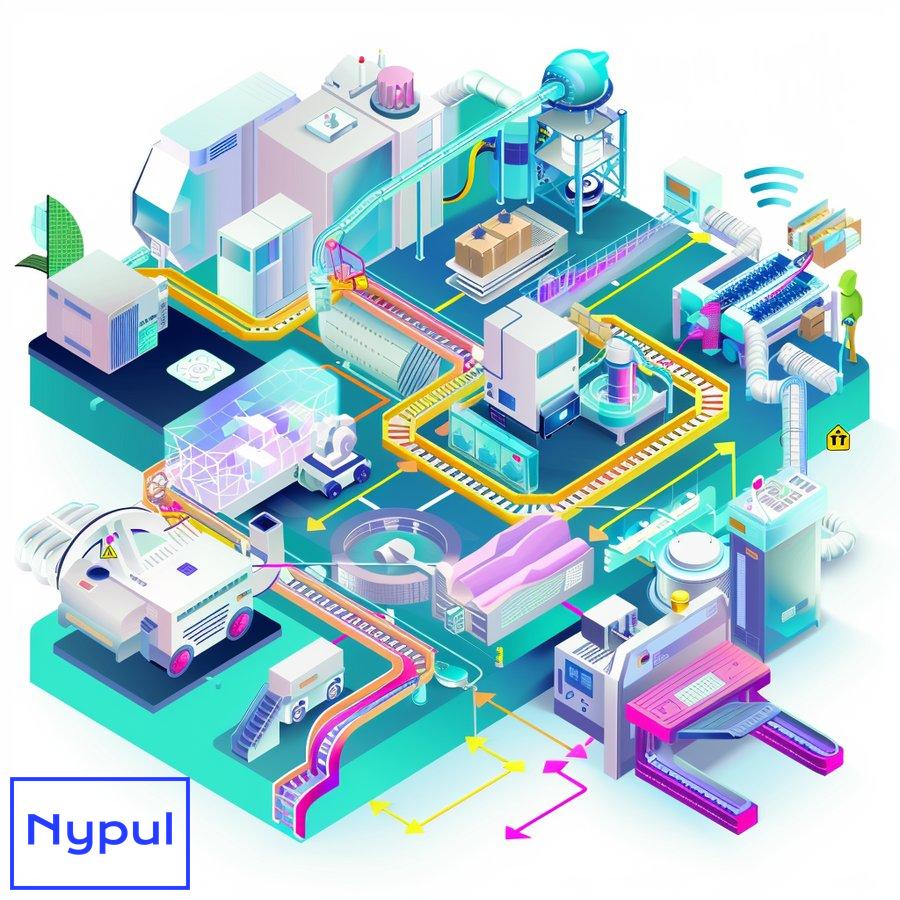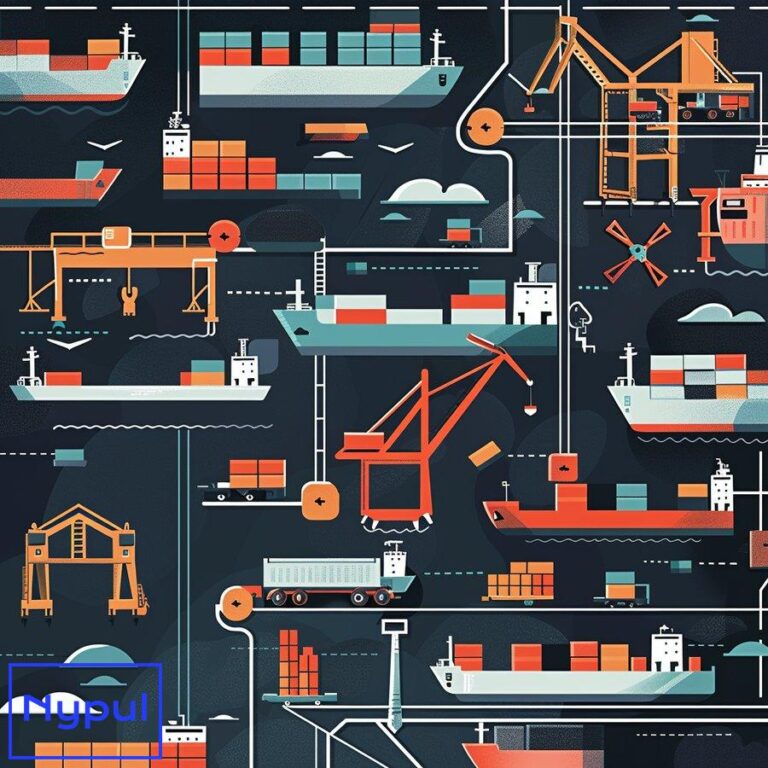What Are Digital Twins for Process Optimization
What are Digital Twins and How Do They Work?
Digital twins are virtual replicas of physical objects, processes, or systems that bridge the gap between the physical and digital worlds. These sophisticated digital models utilize real-time data and advanced analytics to simulate, predict, and optimize their real-world counterparts. The concept of digital twins has revolutionized various industries, offering unprecedented insights and control over complex systems.
At its core, a digital twin consists of three main components:
Physical Entity: This is the actual object, process, or system being replicated. It can range from a single machine component to an entire manufacturing plant or even a city’s infrastructure.
Virtual Model: A highly detailed digital representation of the physical entity, created using 3D modeling, simulation software, and data analytics tools.
Data Connection: The link between the physical and virtual entities, typically facilitated by Internet of Things (IoT) sensors and data transmission technologies.
The working principle of digital twins involves a continuous cycle of data collection, analysis, and feedback:
-
Data Collection: IoT sensors attached to the physical entity gather real-time data on various parameters such as temperature, pressure, vibration, and performance metrics.
-
Data Transmission: The collected data is securely transmitted to the virtual model, often through cloud-based platforms or edge computing systems.
-
Data Analysis: Advanced analytics tools, including artificial intelligence (AI) and machine learning (ML) algorithms, process the incoming data to update the virtual model and generate insights.
-
Simulation and Prediction: The virtual model simulates the behavior of the physical entity under different conditions, predicting potential outcomes and identifying optimization opportunities.
-
Feedback and Optimization: Insights derived from the digital twin are used to optimize the physical entity’s performance, either through automated adjustments or human intervention.
This continuous feedback loop enables organizations to monitor, analyze, and optimize their assets and processes in real-time, leading to improved efficiency, reduced downtime, and enhanced decision-making capabilities.
To illustrate the concept further, consider a digital twin of a wind turbine:
| Component | Physical Entity | Virtual Model | Data Connection |
|---|---|---|---|
| Blades | Actual turbine blades | 3D model with material properties | Strain gauges, accelerometers |
| Gearbox | Physical gearbox | Simulated mechanical system | Vibration sensors, oil analysis |
| Generator | Real generator | Electrical system model | Current and voltage sensors |
| Weather Conditions | Local environment | Weather simulation | Anemometers, thermometers |
In this example, the digital twin continuously monitors the wind turbine’s performance, predicts maintenance needs, and optimizes energy production based on real-time weather conditions and equipment status.
The power of digital twins lies in their ability to provide a holistic view of complex systems, enabling organizations to:
Predict Failures: By analyzing historical data and current operating conditions, digital twins can forecast potential equipment failures before they occur, allowing for proactive maintenance.
Optimize Performance: Through continuous simulation and analysis, digital twins can identify opportunities for performance improvements and suggest optimal operating parameters.
Enhance Design: Insights gained from digital twins of existing products or processes can inform the design of next-generation solutions, leading to more efficient and reliable systems.
Improve Decision-Making: By providing real-time insights and predictive capabilities, digital twins empower decision-makers with accurate, data-driven information.
As technology continues to advance, the capabilities and applications of digital twins are expanding rapidly. From manufacturing and healthcare to urban planning and space exploration, digital twins are transforming how we understand, manage, and optimize complex systems in the physical world.
What Types of Digital Twins Exist?
Digital twins come in various forms, each designed to serve specific purposes and address different aspects of physical entities or systems. Understanding the types of digital twins is crucial for organizations looking to implement this technology effectively. Let’s explore the main categories of digital twins and their unique characteristics:
Component Twins
Component twins are the most basic form of digital twins, focusing on individual parts or components of a larger system. These twins replicate the behavior and characteristics of specific elements, such as a single machine part or a discrete sensor.
Key features:
– Highly detailed representation of a single component
– Useful for monitoring wear and tear, predicting failures, and optimizing individual part performance
– Often serve as building blocks for more complex digital twin systems
Example: A digital twin of an aircraft engine turbine blade, monitoring its temperature, vibration, and wear patterns.
Asset Twins
Asset twins represent complete physical assets, such as entire machines, vehicles, or buildings. These twins integrate multiple component twins to provide a comprehensive view of the asset’s performance and behavior.
Key features:
– Holistic representation of a complete asset
– Enables system-level optimization and maintenance planning
– Facilitates better understanding of asset lifecycle and performance under various conditions
Example: A digital twin of an entire wind turbine, including its blades, gearbox, generator, and control systems.
System or Unit Twins
System or unit twins model interconnected assets or processes that work together to perform a specific function. These twins focus on the interactions between different components and assets within a larger system.
Key features:
– Represents complex systems with multiple interacting parts
– Allows for optimization of system-wide performance and efficiency
– Helps identify bottlenecks and improve overall system design
Example: A digital twin of a manufacturing production line, including multiple machines, conveyor systems, and robotic arms.
Process Twins
Process twins simulate entire business processes or workflows, encompassing both physical and digital elements. These twins are particularly useful for optimizing complex operations that involve multiple steps and resources.
Key features:
– Models end-to-end processes across an organization
– Enables process optimization, resource allocation, and scenario planning
– Helps identify inefficiencies and opportunities for automation
Example: A digital twin of a supply chain process, from raw material sourcing to final product delivery.
System of Systems Twins
System of systems twins represent the highest level of complexity, modeling entire ecosystems of interconnected systems. These twins are often used for large-scale simulations and optimizations.
Key features:
– Models complex interactions between multiple systems
– Enables optimization at a macro level
– Useful for urban planning, smart city initiatives, and large-scale industrial operations
Example: A digital twin of a smart city, integrating transportation systems, energy grids, water management, and public services.
To better understand the relationships between these types of digital twins, consider the following hierarchy:
| Level | Type of Twin | Scope | Example |
|---|---|---|---|
| 1 | Component Twin | Single part or element | Engine piston |
| 2 | Asset Twin | Complete physical asset | Entire car engine |
| 3 | System/Unit Twin | Interconnected assets | Complete vehicle |
| 4 | Process Twin | End-to-end workflow | Car manufacturing process |
| 5 | System of Systems Twin | Ecosystem of systems | Smart transportation network |
Functional Twins
Functional twins focus on simulating specific functions or behaviors of a system, rather than its physical structure. These twins are particularly useful for optimizing performance and testing different operational scenarios.
Key features:
– Models specific functions or behaviors
– Enables performance optimization and scenario testing
– Useful for training and simulation purposes
Example: A digital twin of an aircraft’s flight control system, simulating its response to various weather conditions and pilot inputs.
Predictive Twins
Predictive twins leverage historical data and machine learning algorithms to forecast future states and behaviors of physical entities or systems. These twins are crucial for predictive maintenance and long-term planning.
Key features:
– Utilizes advanced analytics and AI for forecasting
– Enables proactive maintenance and risk management
– Helps in long-term strategic planning and decision-making
Example: A digital twin of a power plant that predicts equipment failures and energy demand fluctuations.
Prescriptive Twins
Prescriptive twins go beyond prediction to provide recommendations for optimal actions or decisions. These twins use advanced AI algorithms to suggest the best course of action based on current conditions and predicted outcomes.
Key features:
– Provides actionable recommendations
– Optimizes decision-making processes
– Integrates with automated systems for real-time adjustments
Example: A digital twin of a manufacturing facility that suggests optimal production schedules and resource allocation based on current orders, inventory levels, and predicted market demand.
Composite Twins
Composite twins combine multiple types of digital twins to create a more comprehensive and versatile representation of complex systems. These twins integrate various aspects of component, asset, process, and predictive twins to provide a holistic view of an entire operation.
Key features:
– Integrates multiple twin types for comprehensive insights
– Enables multi-level optimization and decision-making
– Provides a scalable framework for expanding digital twin capabilities
Example: A digital twin of an entire automotive manufacturing company, integrating twins of individual components, assembly lines, supply chains, and market demand predictions.
Understanding these various types of digital twins is essential for organizations looking to implement this technology effectively. By selecting the appropriate type or combination of digital twins, businesses can tailor their approach to meet specific needs and objectives, whether it’s optimizing individual components, improving entire processes, or transforming entire industries.
How Do Digital Twins Facilitate Process Optimization?
Digital twins play a crucial role in process optimization by providing a virtual environment for monitoring, analyzing, and improving various aspects of business operations. Their ability to simulate real-world conditions and predict outcomes enables organizations to make data-driven decisions and implement continuous improvements. Let’s explore the key ways digital twins facilitate process optimization:
Real-Time Monitoring and Visualization

Digital twins offer a comprehensive, real-time view of processes, allowing stakeholders to monitor performance metrics, identify bottlenecks, and detect anomalies as they occur.
Key benefits:
– Immediate detection of process deviations
– Enhanced visibility into complex operations
– Improved situational awareness for decision-makers
Example: A digital twin of a manufacturing line provides real-time visualizations of production rates, quality metrics, and equipment status, enabling managers to quickly identify and address issues.
Predictive Maintenance
By analyzing historical data and current operating conditions, digital twins can predict when equipment or systems are likely to fail, enabling proactive maintenance strategies.
Key benefits:
– Reduced unplanned downtime
– Optimized maintenance schedules
– Extended equipment lifespan
Example: A digital twin of a wind turbine predicts blade wear based on weather patterns and operational data, allowing maintenance to be scheduled before failures occur.
Process Simulation and Scenario Planning
Digital twins enable organizations to simulate various scenarios and test process changes in a risk-free virtual environment before implementing them in the real world.
Key benefits:
– Reduced risk of costly mistakes
– Accelerated innovation and process improvements
– Enhanced decision-making through data-driven insights
Example: A digital twin of a supply chain allows logistics managers to simulate the impact of adding new distribution centers or changing transportation routes.
Resource Optimization
By analyzing process flows and resource utilization, digital twins help identify inefficiencies and optimize resource allocation.
Key benefits:
– Improved resource utilization
– Reduced waste and operational costs
– Enhanced overall efficiency
Example: A digital twin of a hospital optimizes staff scheduling and equipment allocation based on predicted patient flow and treatment needs.
Quality Control and Defect Reduction
Digital twins can simulate and analyze production processes to identify potential quality issues and suggest improvements to reduce defects.
Key benefits:
– Improved product quality
– Reduced scrap and rework
– Enhanced customer satisfaction
Example: A digital twin of a pharmaceutical manufacturing process simulates the impact of various parameters on drug quality, helping to optimize production conditions.
Energy Efficiency and Sustainability
By modeling energy consumption and environmental impact, digital twins help organizations optimize their processes for improved sustainability and reduced energy costs.
Key benefits:
– Reduced carbon footprint
– Lower energy costs
– Improved compliance with environmental regulations
Example: A digital twin of a smart building optimizes HVAC and lighting systems based on occupancy patterns and weather conditions, reducing energy consumption.
Continuous Improvement and Learning
Digital twins facilitate a cycle of continuous improvement by constantly analyzing process performance and suggesting optimizations.
Key benefits:
– Ongoing process refinement
– Capture and application of best practices
– Accelerated organizational learning
Example: A digital twin of a customer service process analyzes call patterns and resolution times, suggesting improvements to workflow and training programs.
To illustrate how digital twins facilitate process optimization across different industries, consider the following table:
| Industry | Process | Digital Twin Application | Optimization Outcome |
|---|---|---|---|
| Manufacturing | Production Line | Real-time monitoring and predictive maintenance | 25% reduction in downtime |
| Healthcare | Patient Flow | Resource allocation and scenario planning | 15% improvement in patient throughput |
| Logistics | Supply Chain | Route optimization and inventory management | 20% reduction in transportation costs |
| Energy | Power Plant Operations | Energy efficiency and predictive maintenance | 10% increase in overall efficiency |
| Retail | Inventory Management | Demand forecasting and stock optimization | 30% reduction in stockouts |
Data-Driven Decision Making
Digital twins provide a wealth of data and insights that enable more informed and objective decision-making throughout the organization.
Key benefits:
– Reduced reliance on gut feelings or outdated information
– Improved accuracy of strategic planning
– Enhanced ability to justify and validate decisions
Example: A digital twin of a retail operation provides insights into customer behavior and inventory turnover, informing decisions on store layouts and product placement.
Process Standardization and Best Practices
By capturing and analyzing data from multiple instances of a process, digital twins can help identify best practices and standardize operations across an organization.
Key benefits:
– Consistent quality across different locations or units
– Easier training and onboarding of new staff
– Improved scalability of operations
Example: A digital twin of a franchise restaurant operation identifies the most efficient cooking and serving processes, which are then standardized across all locations.
Adaptive Process Control
Digital twins can enable real-time adjustments to processes based on changing conditions, optimizing performance on the fly.
Key benefits:
– Improved responsiveness to changing conditions
– Optimized performance under varying circumstances
– Reduced need for manual interventions
Example: A digital twin of an autonomous vehicle adjusts its driving parameters in real-time based on traffic conditions, weather, and road quality.
Cross-Functional Collaboration
Digital twins provide a common platform for different departments to visualize and understand complex processes, fostering better collaboration and holistic optimization.
Key benefits:
– Improved communication between departments
– Holistic approach to process optimization
– Reduced silos and increased synergies
Example: A digital twin of a product development process allows engineering, manufacturing, and marketing teams to collaborate on design optimizations that consider both technical and market factors.
Customer Experience Optimization
By simulating and analyzing customer interactions, digital twins can help optimize processes to enhance the overall customer experience.
Key benefits:
– Improved customer satisfaction
– Increased customer loyalty and retention
– Enhanced competitiveness in the market
Example: A digital twin of a theme park simulates visitor flows and wait times, helping optimize ride schedules and staff allocation to improve the guest experience.
Digital twins are powerful tools for process optimization, offering a wide range of capabilities that can transform how organizations operate. By providing real-time insights, predictive capabilities, and a platform for simulation and experimentation, digital twins enable businesses to make data-driven decisions, implement continuous improvements, and stay competitive in an increasingly complex and dynamic business environment.
The key to successful process optimization with digital twins lies in their ability to provide a holistic, data-driven view of operations, enabling organizations to identify inefficiencies, predict outcomes, and implement targeted improvements. As technology continues to advance, the potential for digital twins to drive process optimization across various industries will only grow, leading to more efficient, sustainable, and innovative business practices.
What Are the Key Benefits of Implementing Digital Twins?
Implementing digital twins offers a wide array of benefits that can significantly impact an organization’s performance, efficiency, and competitiveness. These virtual replicas of physical assets, processes, and systems provide valuable insights and capabilities that were previously difficult or impossible to achieve. Let’s explore the key benefits of implementing digital twins:
Enhanced Decision Making
Digital twins provide real-time data and predictive insights, enabling more informed and timely decision-making across all levels of an organization.
Key advantages:
– Data-driven decisions based on accurate, up-to-date information
– Ability to simulate and evaluate multiple scenarios before implementation
– Reduced risk of costly mistakes due to incomplete or outdated information
Example: A digital twin of a city’s transportation system helps urban planners make informed decisions about infrastructure investments by simulating the impact of various options on traffic flow and public transit efficiency.
Improved Operational Efficiency
By providing a comprehensive view of operations and identifying inefficiencies, digital twins help organizations streamline processes and optimize resource allocation.
Key advantages:
– Identification and elimination of bottlenecks
– Optimized resource utilization
– Reduced waste and operational costs
Example: A digital twin of a manufacturing plant identifies underutilized equipment and suggests process changes that increase overall production efficiency by 15%.
Predictive Maintenance
Digital twins enable organizations to move from reactive to predictive maintenance strategies, reducing downtime and extending asset lifespans.
Key advantages:
– Reduced unplanned downtime
– Optimized maintenance schedules
– Extended equipment lifespan
– Lower maintenance costs
Example: A digital twin of an offshore oil rig predicts equipment failures based on operational data and environmental conditions, allowing maintenance to be scheduled during planned downtimes and reducing unplanned outages by 30%.
**Accelerate## What Challenges Do Organizations Face When Adopting Digital Twins?
While digital twins offer numerous benefits, organizations may face several challenges when adopting this technology. Understanding these challenges is crucial for developing effective strategies and overcoming potential roadblocks. Let’s explore some of the key challenges organizations face when implementing digital twins:
Data Integration and Interoperability
Integrating data from various sources and ensuring seamless interoperability between different systems is a significant challenge. Digital twins rely on vast amounts of data from multiple systems, and ensuring data quality, consistency, and compatibility is crucial for accurate simulations and insights.
Key challenges:
– Integrating data from legacy systems and new technologies
– Ensuring data security and privacy
– Overcoming data silos within the organization
Example: A manufacturing company struggles to integrate data from its production line sensors, enterprise resource planning (ERP) system, and customer relationship management (CRM) software, limiting the effectiveness of its digital twin.
Talent and Skill Gaps
Implementing and maintaining digital twins requires specialized skills in areas such as data science, simulation modeling, and systems engineering. Many organizations face challenges in finding and retaining talent with the necessary skills to develop and manage digital twins.
Key challenges:
– Shortage of skilled professionals in emerging technologies
– Difficulty in upskilling existing workforce
– Competing with technology giants for top talent
Example: A healthcare organization lacks the in-house expertise to develop and deploy digital twins for its medical equipment and patient care processes, leading to delays and suboptimal results.
Organizational Resistance to Change
Adopting digital twins often requires significant changes in processes, workflows, and mindsets. Organizations may face resistance from employees who are comfortable with traditional methods or are skeptical about the benefits of digital twins.
Key challenges:
– Overcoming inertia and fear of change
– Aligning digital twin initiatives with organizational goals
– Ensuring buy-in from stakeholders at all levels
Example: A logistics company struggles to implement digital twins for its supply chain processes due to resistance from middle managers who are hesitant to adopt new technologies and change established workflows.
Scalability and Complexity
As digital twin initiatives grow in scope and scale, organizations may face challenges in managing the increasing complexity and ensuring seamless scalability.
Key challenges:
– Maintaining performance and accuracy as the number of digital twins grows
– Integrating and managing multiple types of digital twins
– Ensuring consistent data quality and governance across the organization
Example: A smart city project struggles to scale its digital twin beyond a few pilot neighborhoods due to the complexity of integrating data from various municipal departments and maintaining real-time performance.
Return on Investment (ROI) Measurement
Quantifying the benefits of digital twins and demonstrating a clear ROI can be challenging, especially in the short term. Organizations may face difficulties in identifying and measuring the financial and operational impact of digital twin initiatives.
Key challenges:
– Defining and tracking relevant Key Performance Indicators (KPIs)
– Attributing improvements to specific digital twin initiatives
– Justifying long-term investments in a rapidly changing technological landscape
Example: A manufacturing company finds it challenging to quantify the ROI of its digital twin program, as the benefits are spread across various departments and are difficult to isolate from other improvement initiatives.
Regulatory and Ethical Considerations
Digital twins may raise concerns related to data privacy, security, and ethical use of technology. Organizations must navigate a complex landscape of regulations and ensure that their digital twin initiatives adhere to relevant laws and industry standards.
Key challenges:
– Complying with data privacy regulations
– Ensuring the ethical use of AI and machine learning algorithms
– Addressing concerns about job displacement due to automation
Example: A healthcare organization implementing digital twins for patient monitoring faces challenges in ensuring compliance with patient privacy laws and gaining patient trust in the use of this technology.
To overcome these challenges, organizations must adopt a holistic approach to digital twin implementation, focusing on people, processes, and technology. This includes investing in talent development, fostering a culture of innovation and change, and collaborating with partners and vendors to leverage best practices and emerging technologies. By proactively addressing these challenges, organizations can unlock the full potential of digital twins and drive sustainable growth and innovation.
How Can Digital Twins Enhance Operational Efficiency?

Digital twins have the power to significantly enhance operational efficiency across various industries by providing real-time insights, predictive capabilities, and optimization opportunities. By creating virtual replicas of physical assets, processes, and systems, organizations can simulate, analyze, and optimize their operations in ways that were previously impossible. Let’s explore how digital twins can enhance operational efficiency:
Real-Time Monitoring and Anomaly Detection
Digital twins enable real-time monitoring of operational parameters, allowing organizations to quickly identify and address anomalies or deviations from expected performance.
Key benefits:
– Immediate detection of issues or inefficiencies
– Reduced downtime and lost productivity
– Enhanced situational awareness for decision-makers
Example: A digital twin of a wind turbine continuously monitors vibration, temperature, and power output data, alerting operators to potential issues before they lead to equipment failures or reduced energy generation.
Predictive Maintenance and Asset Optimization
By analyzing historical data and current operating conditions, digital twins can predict when equipment or systems are likely to fail, enabling proactive maintenance strategies and optimizing asset utilization.
Key benefits:
– Reduced unplanned downtime
– Optimized maintenance schedules
– Extended equipment lifespan
– Lower maintenance costs
Example: A digital twin of a mining haul truck predicts component failures based on usage patterns and environmental conditions, allowing maintenance to be scheduled during planned downtimes and reducing unplanned outages by 30%.
Process Simulation and Scenario Planning
Digital twins enable organizations to simulate various scenarios and test process changes in a risk-free virtual environment before implementing them in the real world.
Key benefits:
– Reduced risk of costly mistakes
– Accelerated innovation and process improvements
– Enhanced decision-making through data-driven insights
Example: A digital twin of an oil refinery allows operators to simulate the impact of equipment upgrades or process changes on overall throughput, energy efficiency, and product quality, enabling them to optimize operations before making significant investments.
Resource Optimization and Allocation
By analyzing process flows and resource utilization, digital twins help identify inefficiencies and optimize resource allocation, ensuring that assets, materials, and personnel are deployed in the most effective manner.
Key benefits:
– Improved resource utilization
– Reduced waste and operational costs
– Enhanced overall efficiency
Example: A digital twin of a hospital emergency department optimizes staff scheduling and equipment allocation based on predicted patient flow and treatment needs, reducing wait times and improving patient outcomes.
Quality Control and Process Improvement
Digital twins can simulate and analyze production processes to identify potential quality issues and suggest improvements to reduce defects and enhance product quality.
Key benefits:
– Improved product quality
– Reduced scrap and rework
– Enhanced customer satisfaction
Example: A digital twin of a semiconductor manufacturing process simulates the impact of various parameters on chip performance and yield, helping to optimize production conditions and reduce costly defects.
Energy Efficiency and Sustainability
By modeling energy consumption and environmental impact, digital twins help organizations optimize their operations for improved sustainability and reduced energy costs.
Key benefits:
– Reduced carbon footprint
– Lower energy costs
– Improved compliance with environmental regulations
Example: A digital twin of a commercial building optimizes HVAC and lighting systems based on occupancy patterns and weather conditions, reducing energy consumption and operating costs while maintaining occupant comfort.
Supply Chain Optimization
Digital twins can model and simulate entire supply chain networks, identifying bottlenecks, optimizing inventory levels, and improving overall responsiveness to changing market conditions.
Key benefits:
– Reduced inventory costs
– Improved customer service levels
– Enhanced supply chain resilience
Example: A digital twin of a global supply chain allows a manufacturing company to simulate the impact of disruptions, such as natural disasters or trade disputes, on its ability to meet customer demand, enabling it to develop contingency plans and build resilience.
Workforce Training and Upskilling
Digital twins provide immersive, risk-free environments for training and upskilling employees, allowing them to practice critical tasks and procedures without disrupting live operations.
Key benefits:
– Improved employee competency and confidence
– Reduced risk of human error in live operations
– Accelerated onboarding and training for new hires
Example: A digital twin of a nuclear power plant control room enables operators to practice emergency response procedures and familiarize themselves with complex systems, ensuring they are prepared to handle real-world situations safely and effectively.
By leveraging these capabilities, organizations can drive significant improvements in operational efficiency, reducing costs, enhancing quality, and improving overall competitiveness. However, realizing these benefits requires a strategic approach to digital twin implementation, including aligning initiatives with business goals, investing in necessary infrastructure and talent, and fostering a culture of continuous improvement.
In What Industries Are Digital Twins Most Effectively Used?
Digital twins have applications across a wide range of industries, each with its unique challenges and opportunities. While the specific use cases may vary, the core principles of creating virtual replicas, analyzing real-time data, and optimizing operations remain consistent. Let’s explore some of the industries where digital twins are being most effectively used:

Manufacturing
Manufacturing is one of the industries that has embraced digital twins most enthusiastically, using them to optimize production processes, predict equipment failures, and enhance quality control.
Key applications:
– Production line optimization
– Predictive maintenance of equipment
– Quality control and defect reduction
– Supply chain optimization
Example: Siemens uses digital twins to optimize its manufacturing processes, reducing production time by 85% and increasing quality by 90%.
Energy and Utilities
The energy and utilities sector has been at the forefront of digital twin adoption, using them to optimize asset performance, predict maintenance needs, and enhance grid resilience.
Key applications:
– Asset performance optimization
– Predictive maintenance of power plants and grid infrastructure
– Simulation of renewable energy integration
– Optimization of energy storage and distribution
Example: GE Power uses digital twins to optimize the performance of its gas turbines, reducing maintenance costs by 20% and increasing efficiency by 5%.
Transportation and Logistics
Digital twins are transforming the transportation and logistics industry, enabling real-time optimization of routes, fleet management, and infrastructure planning.
Key applications:
– Route optimization and fleet management
– Infrastructure planning and maintenance
– Predictive maintenance of vehicles and equipment
– Supply chain optimization
Example: Maersk uses digital twins to optimize its container shipping operations, reducing fuel consumption by 10% and improving on-time delivery by 15%.
Healthcare
The healthcare industry is leveraging digital twins to optimize patient care, predict disease progression, and enhance medical device performance.
Key applications:
– Patient care optimization
– Predictive modeling of disease progression
– Medical device performance optimization
– Clinical trial simulation
Example: Johnson & Johnson uses digital twins to optimize the design and performance of its medical devices, reducing development time by 30% and improving patient outcomes.
Smart Cities
Smart cities are increasingly adopting digital twins to optimize urban planning, infrastructure management, and resource allocation.
Key applications:
– Urban planning and infrastructure optimization
– Traffic management and optimization
– Resource allocation and optimization
– Emergency response planning and simulation
Example: Singapore uses digital twins to optimize its urban planning and infrastructure management, reducing traffic congestion by 20% and improving energy efficiency by 15%.
Aerospace and Defense
The aerospace and defense industry is using digital twins to optimize aircraft and spacecraft design, predict maintenance needs, and enhance mission planning.
Key applications:
– Aircraft and spacecraft design optimization
– Predictive maintenance of equipment
– Mission planning and simulation
– Training and simulation for pilots and astronauts
Example: Boeing uses digital twins to optimize the design and performance of its aircraft, reducing development time by 20% and improving fuel efficiency by 5%.
Consumer Goods
The consumer goods industry is leveraging digital twins to optimize product design, supply chain management, and customer experience.
Key applications:
– Product design optimization
– Supply chain optimization
– Demand forecasting and inventory management
– Customer experience optimization
Example: Procter & Gamble uses digital twins to optimize the design and performance of its consumer products, reducing development time by 30% and improving customer satisfaction by 20%.
While these industries have been at the forefront of digital twin adoption, the potential applications of this technology are vast and growing. As digital twin capabilities continue to evolve and become more accessible, we can expect to see increasing adoption across a wide range of industries and applications.
How Do Digital Twins Integrate with IoT and AI Technologies?
Digital twins are most effective when integrated with other emerging technologies, such as the Internet of Things (IoT) and Artificial Intelligence (AI). These technologies work together to create a powerful ecosystem that enables real-time data collection, advanced analytics, and intelligent decision-making. Let’s explore how digital twins integrate with IoT and AI technologies:
IoT Integration
IoT technologies are essential for providing the real-time data that powers digital twins. IoT sensors collect vast amounts of data from physical assets, processes, and systems, which is then transmitted to the digital twin for analysis and optimization.
Key benefits of IoT integration:
– Real-time data collection from physical assets
– Continuous monitoring of operational parameters
– Improved accuracy and relevance of digital twin simulations
Example: A digital twin of a manufacturing plant integrates with IoT sensors on production equipment to collect real-time data on temperature, vibration, and performance metrics, enabling predictive maintenance and process optimization.
AI and Machine Learning
AI and machine learning algorithms are crucial for analyzing the vast amounts of data generated by digital twins and IoT systems. These technologies enable digital twins to identify patterns, predict outcomes, and suggest optimizations based on historical data and real-time inputs.
Key benefits of AI integration:
– Advanced data analysis and pattern recognition
– Predictive modeling and forecasting
– Automated decision-making and optimization
Example: A digital twin of a wind farm uses AI algorithms to analyze historical weather data, equipment performance, and real-time sensor inputs to predict energy generation, optimize turbine pitch angles, and identify potential equipment failures.
Edge Computing
Edge computing enables the processing of data closer to the source, reducing latency and improving responsiveness in digital twin applications. By processing data at the edge, digital twins can make real-time decisions and adjustments without relying on cloud-based infrastructure.
Key benefits of edge computing integration:
– Reduced latency and improved responsiveness
– Ability to operate in areas with limited connectivity
– Enhanced data security and privacy
Example: A digital twin of a mining haul truck uses edge computing to process sensor data and make real-time adjustments to engine parameters, improving fuel efficiency and reducing emissions without relying on a cloud-based connection.
Blockchain Integration
Blockchain technology can enhance the security and traceability of digital twin data, ensuring that information is immutable and tamper-proof. By integrating blockchain, digital twins can create a secure, decentralized record of asset history and transactions.
Key benefits of blockchain integration:
– Secure and immutable data storage
– Improved traceability and transparency
– Enabling of smart contracts and automated transactions
Example: A digital twin of a luxury goods supply chain integrates with blockchain technology to create a secure, transparent record of product provenance, enabling customers to verify the authenticity of their purchases.
Augmented and Virtual Reality
Augmented Reality (AR) and Virtual Reality (VR) technologies can enhance the visualization and interaction capabilities of digital twins, enabling users to view and manipulate virtual models in immersive, three-dimensional environments.
Key benefits of AR/VR integration:
– Improved visualization and understanding of complex systems
– Ability to interact with digital twins in real-time
– Enhanced training and simulation capabilities
Example: A digital twin of a nuclear power plant control room integrates with VR technology to create an immersive training environment for operators, allowing them to practice emergency procedures and familiarize themselves with control systems without disrupting live operations.
By integrating these technologies, digital twins become more powerful, responsive, and effective in optimizing complex systems and processes. As these technologies continue to evolve and converge, we can expect to see even more advanced and sophisticated digital twin applications emerge across various industries.
Conclusion
Digital twins are transforming the way organizations operate, enabling them to optimize processes, predict outcomes, and enhance decision-making. By creating virtual replicas of physical assets, processes, and systems, digital twins provide valuable insights and capabilities that were previously difficult or impossible to achieve.
The key benefits of implementing digital twins include:

- Enhanced decision-making through real-time data and predictive insights
- Improved operational efficiency and resource optimization
- Predictive maintenance strategies that reduce downtime and extend asset lifespans
- Accelerated innovation and process improvements through simulation and scenario planning
- Enhanced quality control and defect reduction
- Improved energy efficiency and sustainability
While implementing digital twins presents challenges related to data integration, talent gaps, organizational resistance to change, and ROI measurement, organizations that proactively address these challenges can unlock the full potential of this transformative technology.
Digital twins are being most effectively used in industries such as manufacturing, energy and utilities, transportation and logistics, healthcare, smart cities, aerospace and defense, and consumer goods. By integrating digital twins with IoT, AI, edge computing, blockchain, and AR/VR technologies, organizations can create powerful ecosystems that enable real-time data collection, advanced analytics, and intelligent decision-making.
As digital twin capabilities continue to evolve and become more accessible, we can expect to see increasing adoption across a wide range of industries and applications. Organizations that embrace this technology and develop effective strategies for implementation will be well-positioned to drive innovation, enhance competitiveness, and thrive in an increasingly complex and dynamic business environment.






